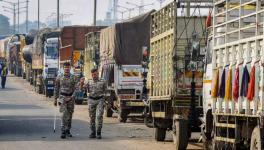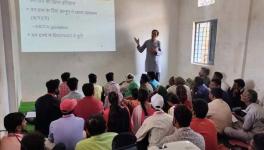‘Anaemia Mukt Bharat’ a Distant Dream due to Weak Public Health Sector, Budget Cuts
The Central government announced the "Anaemia Mukt Bharat" initiative in 2018 to eradicate anaemia by 2020, which includes hemoglobinopathies, such as sickle cell anaemia (SCA). After failing to meet this goal, the government came up with another announcement in its Union Budget for 2023-24 that it will work in "mission mode" to eradicate the condition by 2047.
How would the government eradicate the condition by 2047 without standardised treatment recommendations or a systematic functional system for the prevention and management of SCA? The ministry released a guideline to prevent and control blood disorders and diseases that affect the blood (hemoglobinopathies) in 2016, including SCA, with a number of implementation gaps. These guidelines and corresponding programmes drew little attention from many state health departments.
What is Sickle Cell Anaemia?
Western medical literature noticed the first description of SCA in 1910 when Dr James Herrick noticed a unique red blood cell in an anaemic student from Spain. These were unique because these were shaped like a sickle, similar to the letter C, as opposed to their typical globular structure with an intended centre, like a doughnut with a hole. In India, the first case of SCA was reported in the Nilgiri Highlands in 1952 when researchers H. Lehmann and Marie Cutbush were studying the tribal communities.
SCA is the most prevalent genetic disease in the world, with India having the highest prevalence. It is more prevalent in regions where malaria is endemic and is a product of convergent evolution, where the sickle cell trait offers a survival advantage to people. States and Union Territories with large tribal populations have higher rates of SCA due to endogamy.
SCA is a genetic disorder caused by a point mutation in the gene that generates beta-globin, resulting in haemoglobin sickle (Hbs). This mutation causes red blood cells to become sickle-shaped, resulting in symptoms, such as body aches, clotting, shortness of breath, anaemia, jaundice, pneumonia, and recurrent infections. The average lifespan of people with this condition is 42-48 years, with 50% of children dying before the age of five. Infection is a significant factor in patients who die too soon.
Is it Possible to Eradicate the Condition by 2024?
Since SCA is a genetic disorder, the total eradication of the condition in 20 million people would be difficult and requires a significant technological breakthrough. The only irreversible treatments are gene therapy and stem cell transplants, both expensive and still in the research and development stages. With stem cell transplants, sickle cell anaemia-affected bone marrow is swapped out for healthy bone marrow from a donor, and in gene therapy, the DNA within the haemoglobin gene is changed to end the condition. Worldwide clinical trials are now testing both therapies.
Read Also: Chhattisgarh: Incomplete, Incompetent Strategy is Making Tackling Sickle Cell Disease Difficult
To ride such a gigantic eradication drive, the government should allocate sufficient resources to national health research centres, laboratories, science, and technology. Most importantly, there should be a route map to enhance the public health sector, from PHCs (primary health centres) to research centres. But it is clear from the previous year's budget that the department of health research, the Indian Councial of Medical Research or ICMR, the Ministry of Science and Technology, and the medical sector are experiencing budget cuts.
In addition to decreased R&D (research & development) funds and health sector spending, the Union government curtailed financing for a number of disability initiatives, including the implementation of the Rights of Persons with Disability or RPD Act 2016, even though blood diseases, including SCA, are protected under the Act.
Screening parents and diagnosing the problem in the foetus requires costly procedures. The high genetic frequency of the disease further adds to this already high cost. Screening such a large population, most of them in tribal regions, to identify whether the disease is being passed on to their offspring at the state of the foetus is a mammoth undertaking, for which the 2023–24 Union Budget makes no allocation.
The government’s announcement focuses on screening tribal populations and providing genetic counselling. In 200 districts with the most afflicted residents, the Union Health Ministry, the Tribal Affairs Ministry, and some states have claimed to have established a roadmap for screening about seven crore people under 40. However, only about 1% of the Health Ministry's goal to screen one crore people for SCA in 2022–23 has been met.
Read Also:Union Govt. Irresponsible Towards At-Risk Citizens in its Ill-Conceived Approach to Fortified Rice
The National Health Mission (NHM) aimed to screen about one crore individuals, but according to the minutes of a meeting of the seventh Mission Steering Group, just 1,054,954 have been screened so far. (By the time this article is published, a few numbers may have varied slightly)
According to the screening results, cards will be given to tribal members under the age of 40 and will be divided into different categories. One significant downside of counselling is that it denigrates gene carriers who get the card. Girls are particularly affected by this. People around her isolate her and declare that she is cursed. Patients with HIV in India receive confidential counselling and treatment to avoid social stigma, but no such confidentiality is offered to anyone with SCA.
The NHM guidelines on hemoglobinopathies recommend establishing pre-marital and pre-conception screening facilities in the local community, backed by genetic counselling services. These counselling sessions will educate the carriers about the risks of having biological children. During pre-marital counselling, partners are informed about how SCA may affect their unborn child.
The issue with open counselling is that SCA patients encounter a lot of discrimination; some are so stigmatised that they delay getting tested or getting treatment out of fear that they will test positive. Another major problem is discrimination based on gender. Health issues are mostly beyond the control of women. In addition, one in five women experiences domestic violence and other forms of abuse in their homes.
In order to gather information about SCA across tribal communities, the Ministry of Tribal Affairs developed a portal where people could register themselves, whether or not they have the condition. The availability of Internet services and people's access to those services are determined by several factors, including their location, gender, education, language, age, and ability. Although mobile networks have spread to most of India's urban areas, there is still a long way to go because mobile signals don't yet touch 42,300 villages.
People living in remote, hilly areas far from the nearest health centres, rely on traditional healers. The government's assumption that communities living in such conditions will access the Internet to upload information about their genetic condition is unlikely to be realised. Even assuming such information could be collected online, the security of such data remains another question.
Without effective long-term treatment, blood transfusions are another reliable option. Blood transfusion is an important treatment for acute and chronic complications, but only a few patients can access safe and reliable supply. According to the state government's proposal, the Central government claims to offer free blood transfusions to all sickle cell patients (men and women), but a serious question remains:
How can India, which has the world's biggest requirement for blood units, guarantee a secure and reliable supply?
Another commitment connected to therapy is that the government will support capsule hydroxyurea under NHM in accordance with the state proposal. What kind of support would be provided—whether the government would distribute the capsules for free or at a subsidised rate—is unclear.
Since hydroxyurea's initial usage in 1990, symptoms and mortality have significantly decreased, and there is evidence that it benefits both acute and long-term problems. A person with SCA needs to take at least one capsule daily; in some cases, it may be recommended to take two capsules, making the total number of hydroxyurea capsules be taken between 30-60. One strip of hydroxyurea costs between Rs 130-180 and contains 10 capsules. Therefore, the cost of the tablet itself is Rs 1,080/month. Currently, only Kerala and Tamil Nadu supply hydroxyurea free of charge.
The pathophysiology of the disease has direct dietary consequences, which are neglected, underutilised, and underdeveloped. Those with SCA need to consume a nutritious diet to avoid being deficient in immune-boosting nutrients, as their metabolism is working on overdrive, and their nutrients are diverted away from bodily processes to make more healthy red blood cells. A diet recommended for SCA patients consists of fruits, vegetables, whole grains, and legumes recommended as part of a regular diet.
Supplementing with additional multivitamins, amino acids, and folic acid can help avoid nutritional deficiencies and lessen the chance that a condition will worsen. SCA patients should get vaccines, a balanced diet, and an iron-free multivitamin to reduce painful episodes and hospital visits.
Read Also: Activists Object to Distribution of Fortified Rice Through PDS
The Union government is aggressively pushing for the fortification of rice, wheat, edible oils, salt, and milk. Those with SCA, thalassemia, acute infections, acute malnutrition, certain stages of malaria, diabetes, or tuberculosis shouldn't consume iron-fortified foods, say experts. The government has been providing iron-fortified rice through the public distribution system, mid-day meals, and anganwadis.
For these predominantly poor communities, especially the tribal community, iron-fortified rice has become essential because they cannot afford to buy regular (non-fortified) rice from the open market.
According to the Union government, thalassemia-SCA patients must be warned on the label of rice that has been fortified. State-run food agencies and commercial producers of fortified foods must display the "+F" logo and a health warning for those with blood diseases, such as SCA and thalassemia on the packaging, according to the Food Safety and Standards Authority of India.
But, in reality, it has been often discovered that bags of fortified rice are being sold without the required labelling. Consumers and fair-price shop owners, who sell grains at subsided prices, have not been informed of the health risks. The government has not yet attempted to offer such consumers non-fortified rice.
People with sickle cell disease can attain adequate nutrition and immunological function with the help of customised diet, lowering their risk of sickness and mortality. In addition to cutting the funding for food subsidies in the 2023-24 Budget, the government has also failed to include any additional nutritional assistance for those with SCA in its eradication drive.
In our severely underfunded public health system, the only option to eradicate the disease is to force those with the condition to give up marriage or mating entirely, or sterilise the patients forcefully.
Given that the disease is concentrated among the tribal community, which is already subjected to systematic (and often violent) repression, the risk of this disease being used by the current Right-wing government to depopulate their regions seems real.
Some such efforts in that direction can be observed by the ruling Bharatiya Janata Party government's recent events, which includes holding a mass wedding among marginalised and tribal communities, distributing makeup kits with contraceptive pills and condoms in Madhya Pradesh's Jhabua district, which has a high index of sickle cell anaemia, and conducting pregnancy tests while pretending to be screening for SCA in Dindori district.
The writer works as a Research Associate with the National Platform for the Rights of the Disabled. The views are personal.
Get the latest reports & analysis with people's perspective on Protests, movements & deep analytical videos, discussions of the current affairs in your Telegram app. Subscribe to NewsClick's Telegram channel & get Real-Time updates on stories, as they get published on our website.
























